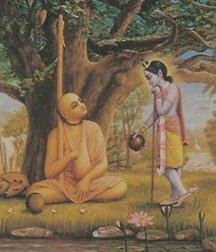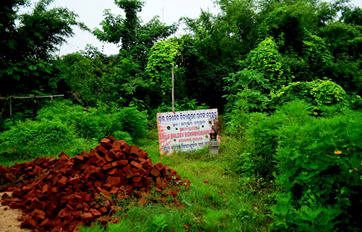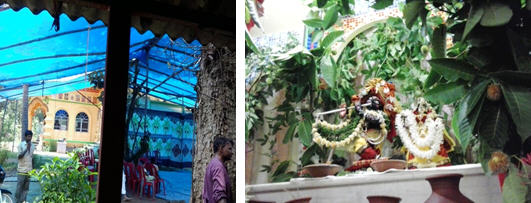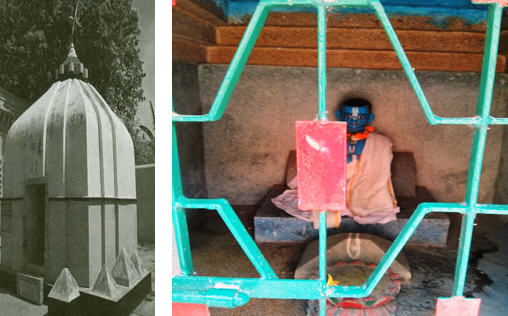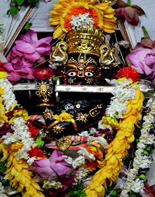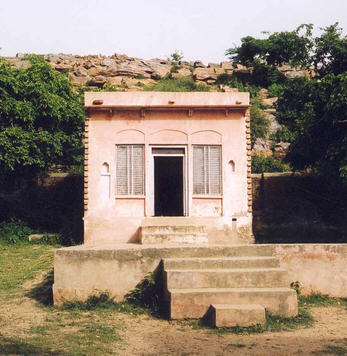
Madhavendra Puri found the Deity of Gopala at this place while staying at Govinda Kunda, about 500 years ago, This place is very close to Govardhana Hill, so one has to be careful not to step on Govardhana when coming to this place. Sri Gopala was discovered before Lord Caitanya came to Vrindavana.
This Gopala Deity is now known as Sri Nathaji and is wor¬shiped at Nathdwar in Rajasthan.
Getting there
This place is almost right next to Govardhana Hill, below where the old temple of Gopala is located, on the edge of the village of Aniyora. It is about a minute walk from Sankarsana Kunda.
Gopala
Sri Gopala (Nathaji) is a beautiful black marble Deity of Lord Krishna, standing with His hand upraised lifting Govardhana Hill. Sri Gopala is Lord Krishna in His pastime of lifting Govardhana Hill. This Deity was originally installed by Vajranabha, the great-grandson of Lord Krishna, 4900 years ago. The Lord's left hand is upraised. His right hand, closed in a fist, rests on His hip. His eyes glance downward affectionately at His devo¬tees. Sri Nathaji is a very special and beautiful Deity.
The Deity appears in a large black stone from which His form emerges in bas-relief. The stone around the Deity bears several marks: two cows, a snake, a lion, two peacocks, a parrot by the Lord's head, two sages seated on His right side and a third on His left, and then below the sages is another snake. Around the Lord's neck is a flower garland, resembling a black snake.
After Madhavendra Puri left Vrindavana, two brahmans from Bengal served the Gopala Deity. After time had passed, Raghu¬natha Dasa Gosvami saw that there was a need to find a devotee to serve Gopala. He gave this service to Vitthala, the son of Val¬labhacarya.
Sri Nathaji was brought to Nathdwar by Rana Raja Singh of Mewar, in the 17th century. The temple of Sri Nathaji in Nath¬dwar is said to be the second richest temple in India, after the Balaji Temple in Tirupati.
Discovery Of Gopala
Once Sri Madhavendra Puri traveled to Vrindavana, where he came upon Govardhana. Madhavendra Puri was almost mad in his ecstasy of love of Godhead, and he did not know whether it was day or night. Sometimes he stood up, and sometimes he fell to the ground. He could not discriminate whether he was in a proper place or not. After circumambulating the hill, Madhavendra Puri went to Govinda Kunda and took his bath. He then sat beneath a tree to take his evening rest.
While he was sitting beneath a tree, an unknown cowherd boy came with a pot of milk, placed it before Madhavendra Puri, and, smiling, addressed him as follows," Please drink the milk I have brought. Why don't you beg some food to eat? What kind of meditation are you undergoing?''
When he saw the beauty of that boy, Madhavendra Puri became very satisfied. Hearing His sweet words, he forgot all hunger and thirst.
Madhavendra Puri said, "Who are You? Where do You reside? And how did You know that I was fasting?"
The boy replied, ''Sir, I am a cowherd boy, and I reside in this village. In My village, no one fasts. In this village a person can beg food from others and thus eat. Some people drink only milk, but if a person does not ask anyone for food, I supply him all his eatables. The women who come here to take water saw you, and they supplied Me with this milk and sent Me to you. I must go very soon to milk the cows, but I shall return and take back this milk pot from you."
Saying this, the boy left the place. Indeed, He suddenly could be seen no more, and Madhavendra Puri's heart was filled with wonder
. After drinking the milk, Madhavendra Puri washed the pot and put it aside. He looked towards the path, but the boy never returned. Madhavendra Puri could not sleep. He sat and chanted the Hare Krishna maha-mantra, and at the end of the night he dozed a little, and his external activities stopped. In a dream Madhavendra Puri saw the very same boy.
The boy came before him and holding his hand, took him to a bush in the jungle. The boy showed Madhavendra Puri the bush and said, "I reside in this bush, and because of this I suffer very much from severe cold, rain showers, winds, and scorching heat. Please bring the people of the village and get them to take Me out of this bush. Then place Me nicely on top of the hill.''
"Please construct a temple on the top of that hill," the boy continued, "and install Me in that temple. After this, wash Me with large quantities of cold water so that My body may be cleansed. For many days I have been observing you, and I have been wondering. `When will Madhavendra Puri come here to serve Me? I have accepted your service due to your ecstatic love for Me. Thus I shall appear, and by My audience all fallen souls will be delivered. My name is Gopala. I am the lifter of Govar¬dhana Hill. I was installed by Vajranabha, and here I am the authority. When the Mohammedans attacked, the priest who was serving Me hid Me in this bush in the jungle. Then he ran away out of fear of the attack. Since the priest went away, I have been staying in this bush. It is very good that you have come here. Now just remove Me with care."' (Caitanya Caiitamrita Madhya 4.21-43).
Madhavendra then went to the place where this boy instructed him to go and found the Gopala Deity. A grand installation was held for Sri Gopala. Gopal temple is on the top of Govardhana Hill, not far from Sankarsana Kunda.
